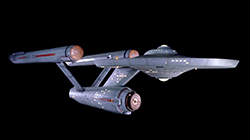
Hidden in a distant galaxy cluster collision are wisps of gas resembling the starship Enterprise — an iconic spaceship from the "Star Trek" franchise.
Galaxy clusters — cosmic structures containing hundreds or even thousands of galaxies — are the largest objects in the Universe held together by gravity. Multi-million-degree gas fills the space in between the individual galaxies. The mass of the hot gas is about six times greater than that of all the galaxies combined. This superheated gas is invisible to optical telescopes, but shines brightly in X-rays, so an X-ray telescope like NASA's Chandra X-ray Observatory is required to study it.
By combining X-rays with other types of light, such as radio waves, a more complete picture of these important cosmic objects can be obtained. A new composite image of the galaxy cluster Abell 1033, including X-rays from Chandra (purple) and radio emission from the Low-Frequency Array (LOFAR) network in the Netherlands (blue), does just that. Optical emission from the Sloan Digital Sky Survey is also shown. The galaxy cluster is located about 1.6 billion light years from Earth.
Using X-ray and radio data, scientists have determined that Abell 1033 is actually two galaxy clusters in the process of colliding. This extraordinarily energetic event, happening from the top to the bottom in the image, has produced turbulence and shock waves, similar to sonic booms produced by a plane moving faster than the speed of sound.
In Abell 1033, the collision has interacted with another energetic cosmic process — the production of jets of high-speed particles by matter spiraling into a supermassive black hole, in this case one located in a galaxy in one of the clusters. These jets are revealed by radio emission to the left and right sides of the image. The radio emission is produced by electrons spiraling around magnetic field lines, a process called synchrotron emission.
The electrons in the jets are traveling at very close to the speed of light. As the galaxy and its black hole moved toward the lower part of the image, the jet on the right slowed down as it crashed into hot gas in the other galaxy cluster. The jet on the left did not slow down because it encountered much less hot gas, giving a warped appearance for the jets, rather than the straight line that is typically seen.
This image of Abell 1033 also provides an example of "pareidolia", a psychological phenomenon where familiar shapes and patterns are seen in otherwise random data. In Abell 1033, the structures in the data create an uncanny resemblance to many of the depictions of the fictional Starship Enterprise from Star Trek.
In terms of astrophysical research, a detailed study of the image shows that the energy of the electrons in the "saucer section" and neck of the starship-shaped radio emission in Abell 1033 is higher than that found in the stardrive section towards the lower left (see labels). This suggests that the electrons have been reenergized, presumably when the jets interact with turbulence or shock waves in the hot gas. The energetic electrons producing the radio emission will normally lose substantial amounts of energy over tens to hundreds of millions of years as they radiate. The radio emission would then become undetectable. However, the vastly extended radio emission observed in Abell 1033, extending over about 500,000 light years, implies that energetic electrons are present in larger quantities and with higher energies than previously thought. One idea is that the electrons have been given a further boost in energy by extra bouts of shocks and turbulence.
Other sources of radio emission in the image besides the starship-shaped object are the shorter jets from another galaxy (labeled "short jets") and a "radio phoenix" consisting of a cloud of electrons that faded in radio emission but was then reenergized when shock waves compressed the cloud. This caused the cloud to once again shine at radio frequencies, as we reported back in 2015.
The team who made this study will use observations with Chandra and LOFAR to look for further examples of colliding galaxy clusters with warped radio emission, to further their understanding of these energetic objects.
A paper describing this result was published in the October 4th, 2017 issue of Science Advances and is available online. The authors of the paper are Francesco de Gasperin, Huib Intema, Timothy Shimwell (Leiden University, the Netherlands), Gianfranco Brunetti (Institute of Radio Astronomy, Italy), Marcus Bruggen (University of Hamburg, Germany), Torsten Enblin (Max Planck Institute for Astrophysics, Germany), Reinout van Weeren (Leiden), Annalisa Bonafede (Hamburg), and Huub Rottgering (Leiden).
NASA's Marshall Space Flight Center in Huntsville, Alabama, manages the Chandra program for NASA's Science Mission Directorate in Washington. The Smithsonian Astrophysical Observatory in Cambridge, Massachusetts, controls Chandra's science and flight operations.
|
||||||||||||||||||||||||||||||


